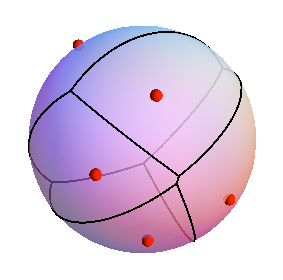Let $G$ be a graph with (positively) weighted edges.
I want to define the Voronoi diagram for a set of nodes/sites $S$, to
associate with a
node $v \in S$
the subgraph $R(v)$ of $G$ induced by all the nodes
strictly closer to $v$ than to any other node
in $S$, measuring the length of a path by the sum of weights on the arcs.
$R(v)$ is $v$'s Voronoi region.
For example, the green nodes below are in $R(v_1)$, and the yellow nodes
are in $R(v_2)$.

I would like to understand the structure of the Voronoi diagram.
As a start, what does the diagram of two sites $v_1$ and $v_2$ look like,
i.e., what does the 2-site bisector look like (blue in the above example)?
I think of the bisector $B(v_1,v_2)$ as the complement of $R(v_1) \cup R(v_2)$
in $G$. Here are two specific questions:
Q1. Is the bisector of two sites connected in some sense?
Q2. Is $R(v)$ convex in the sense that it contains the shortest path between any two nodes in $R(v)$?
Surely this has been studied before. Can anyone provide references/pointers? Thanks!
Addendum for Suresh's comment:

